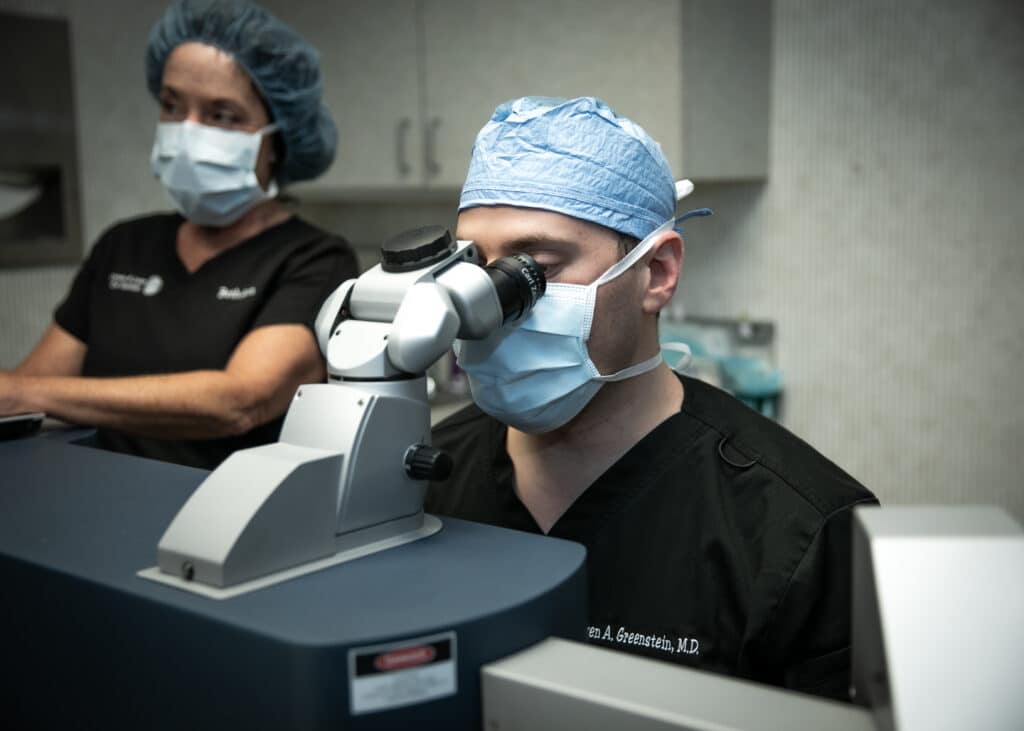In August 2025, Dr. Steven Greenstein was featured in Review of Ophthalmology’s article, “Screening for the Proper Refractive Candidate”. The piece brought together leading refractive surgeons to talk about one of the most important—and often overlooked—parts of laser vision correction: making sure patients are the right candidates for surgery.
When people think about LASIK or other procedures like PRK and SMILE, they usually picture the surgery itself. But as Dr. Greenstein points out, real success begins long before a laser ever touches the eye. Careful LASIK pre screening is what ensures patients not only get great results, but also avoid risks that could compromise their vision.
A Closer Look at the Screening Process
So what exactly goes into screening? The answer: a lot more than a quick eye exam. Surgeons are looking at every layer of the eye, from the corneal surface to the retina at the very back. The doctors cited in Review of Ophthalmology’s article highlighted several interlocking domains of assessment:
1. Corneal tomography and keratoconus screening
A central goal of the screening workup is identifying early or subtle ectatic disease (e.g. keratoconus or subclinical keratoconus) that might contraindicate surgery. Advanced imaging (e.g. Scheimpflug or OCT tomography) is used to detect asymmetries or posterior elevation changes that might otherwise slip past conventional exams.
2. Wavefront aberrometry and internal aberrations
Dr. Greenstein also noted the value of wavefront measurements not just for the corneal surface but for internal optical structures. High internal aberrations may hint at lenticular pathology, such as an early cataract, which would influence surgical planning or candidacy.
3. Fundus exam, OCT, and retinal health
Surgeons agree that reviewing the retina is nonnegotiable. While some practices restrict OCT imaging to indicated cases, most surgeons—including Dr. Greenstein—perform both dilated fundus examination and OCT imaging of the macula and retinal nerve fiber layer (RNFL). This ensures that no occult retinal or optic nerve disease will compromise visual outcomes.
4. Ocular surface / dry eye optimization
Dry eye disease can jeopardize both measurements and postoperative comfort. Dr. Greenstein underscores the importance of discriminating between symptomatic vs. subclinical dryness, the use of Schirmer’s testing, and identifying signs such as superficial punctate keratitis on the cornea. When pathologic dryness is evident, he recommends treating and stabilizing the surface before proceeding.
5. Contextual judgment and patient factors
Beyond imaging, the article emphasizes the surgeon’s clinical judgment, such as patient age, stability of refraction, expectations, and ocular history. The goal is not to exclude broadly, but to stratify risk and tailor the approach.
Why This Matters
If all of this sounds extensive—that’s because it is. But it’s also the reason why patients who choose an experienced surgeon like Dr. Greenstein can feel confident about their results. The screening process is about more than just saying yes or no; it’s about tailoring the plan to each patient’s unique eyes. Sometimes that means recommending a different type of procedure—or holding off until a medical treatment is completed or a medical condition is under control.
Dr. Greenstein explains, “The great thing about our technology now is that we have the ability to make sure that we’re analyzing each patient’s cornea for any pathology beforehand and rule out any disease so that we hopefully determine patients who aren’t good candidates for surgery. Conversely, our technology has allowed us to rule in more patients since we’re able to look at epithelial mapping and get a better sense of the true shape of the cornea. That’s opened up refractive surgery to more patients in many ways.”
This kind of thoughtful, individualized care and a wide range of customized treatment options is what sets refractive specialists apart from a one-size-fits-all approach. And it’s exactly the type of perspective Dr. Greenstein brought to the conversation in Review of Ophthalmology.
Learn More
If you’re thinking about LASIK or another vision correction procedure, the first step is learning whether you’re a good candidate. You can start by reading more about LASIK on our website. And if you’d like to know more about Dr. Greenstein’s background, expertise, and approach to patient care, visit his profile page.
And for those who want to dive into the full professional discussion, you can find the original Review of Ophthalmology article here.
Ready for your LASIK pre screening? Schedule an appointment.





